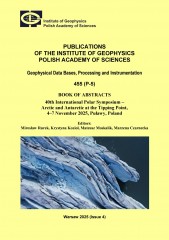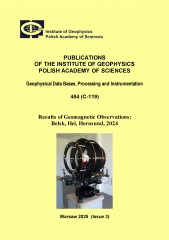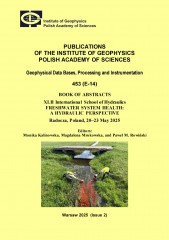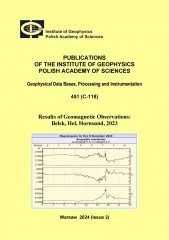BROWSE - VOLUME LIST
- A - Physics of the Earth's Interior
- B - Seismology
-
C - Geomagnetism
C-119, C-118, C-117, C-116, C-115, C-114, C-113, C-112, C-111, C-110, C-109, C-108, C-107, C-106, C-105, C-104, C-103, C-102, C-101, C-100, C-99, C-98, C-97, C-96, C-95, C-94, C-93, C-92, C-91, C-90, C-89, C-88, C-87, C-86, C-85, C-84, C-83, C-82, C-81, C-80, C-79, C-78, C-77, C-76, C-75, C-74, C-73, C-72, C-71, C-70, C-69, C-68, C-67, C-66, C-65, C-64, C-63, C-62, C-61, C-60, C-59, C-58, C-57, C-56, C-55, C-54, C-53, C-52, C-51, C-50, C-49, C-48, C-47, C-46, C-45, C-44, C-43, C-42, C-41, C-40, C-39, C-38, C-37, C-36, C-35, C-33, C-32, C-31, C-30, C-29, C-28, C-27, C-26, C-25, C-24, C-23, C-22, C-21, C-20, C-19, C-18, C-17, C-16, C-15, C-14, C-13, C-12, C-11, C-10, C-9, C-8, C-7, C-6, C-5, C-4, C-3, C-2, C-1
-
D - Physics of the Atmosphere
D-79, D-78, D-77, D-76, D-75, D-74, D-73, D-72, D-71, D-70, D-69, D-68, D-67, D-66, D-65, D-64, D-63, D-62, D-61, D-60, D-59, D-58, D-57, D-56, D-55, D-54, D-53, D-52, D-51, D-50, D-49, D-48, D-47, D-46, D-44, D-45, D-43, D-42, D-41, D-40, D-39, D-38, D-37, D-35, D-34, D-33, D-32, D-31, D-30, D-28, D-27, D-26, D-25, D-24, D-23, D-22, D-21, D-20, D-19, D-18, D-17, D-16, D-15, D-14, D-13, D-12, D-11, D-10, D-9, D-8, D-7, D-6, D-5, D-4, D-3, D-2, D-1
- E - Hydrology
- P - Polar Research
- M - Miscellanea
-
Online First
Browse - Volume list
BOOK OF ABSTRACTS. 40th International Polar Symposium – Arctic and Antarctic at the Tipping Point, 4–7 November 2025, Puławy, Poland
Editor(s): Rurek M., Kozioł K., Moskalik M., Czarnecka M.
Volume: 455
Series: P-5
DOI: 10.25171/InstGeoph_PAS_Publs-2025-067
Volume: 455
Series: P-5
DOI: 10.25171/InstGeoph_PAS_Publs-2025-067
The Polar Symposium is a recurrent conference, typically occurring every two years, dedicated to Arctic and Antarctic topics, with a long tradition dating back to 1972. Since then, these meetings have been an excellent opportunity for integrating the polar community, exchanging experiences, and a discussion between Polish and international polar researchers representing various scientific disciplines. The Polar Symposium is currently co-organised by the Committee of Polar Research, Polish Academy of Sciences, and the Polish Polar Consortium, and until recently it has also been co-organised by the Polar Club of the Polish Geographical Society. Instead, during the 40th International Polar Symposium, a new Polish Polar Club will debut as an independent association, thus continuing the functioning of the Club since 1974.
Results of Geomagnetic Observations: Belsk, Hel, Hornsund, 2024
Author(s): Reda J., Neska M., Wójcik S., Czubak P.
Volume: 454
Series: C-119
DOI: 10.25171/InstGeoph_PAS_Publs-2025-066
Volume: 454
Series: C-119
DOI: 10.25171/InstGeoph_PAS_Publs-2025-066
This publication provides basic information on geomagnetic observations conducted in 2024 at three Polish geophysical observatories: Belsk, Hel, and Hornsund. Their respective IAGA codes are BEL, HLP, and HRN. All three observatories are operated by the Institute of Geophysics, Polish Academy of Sciences (IG PAS). The Belsk and Hel observatories are located in Poland, whereas the Hornsund Observatory is situated on Spitsbergen, under Norwegian administration.
Book of Abstracts. XLII International School of Hydraulics: FRESHWATER SYSTEM HEALTH: A HYDRAULIC PERSPECTIVE. Radocza, Poland, 20–23 May 2025
Editor(s): Kalinowska M., Mrokowska M., Rowiński P.
Volume: 453
Series: E-14
DOI: 10.25171/InstGeoph_PAS_Publs-2025-022
Volume: 453
Series: E-14
DOI: 10.25171/InstGeoph_PAS_Publs-2025-022
The 42nd International School of Hydraulics, titled “Freshwater System Health: A Hydraulic Perspective”, held on May 20–23, 2025, in Radocza near Kraków, continued a series of events focused on broadly understood hydraulics. The conference covered the fundamentals of hydraulics in the context of understanding and managing the health of rivers, lakes, and other aquatic ecosystems.
SVALGEOBASE II: Tectono-thermal Evolution of Svalbard – from Metamorphic and Magmatic Processes to Geothermal Energy. Geological Workshop, Svalbard, 3–9 September 2024
Editor(s): Michalski K., Majka J., Głowacki P., Augland L., Manby G.M., Piepjohn K. ., Guarnieri P., Senger K. .
Volume: 452
Series: P-4
DOI: 10.25171/InstGeoph_PAS_Publs-2025-001
Volume: 452
Series: P-4
DOI: 10.25171/InstGeoph_PAS_Publs-2025-001
We are pleased to present the report from the second edition of the geological workshop SvalGeoBase II, titled “Tectono-thermal evolution of Svalbard – from metamorphic and mag-matic processes to geothermal energy”. Held from September 3 to 9, 2024, in Svalbard, this event continued the legacy of the first edition, SvalGeoBase I, organized in 2013 under the theme “Proterozoic and Lower Palaeozoic basement of Svalbard – state of knowledge and new research perspectives”.
Results of Geomagnetic Observations Belsk, Hel, Hornsund, 2023
Author(s): Reda J., Neska M., Wójcik S., Czubak P.
Volume: 451
Series: C-118
DOI: 10.25171/InstGeoph_PAS_Publs-2024-029
Volume: 451
Series: C-118
DOI: 10.25171/InstGeoph_PAS_Publs-2024-029
This publication contains basic information on geomagnetic observations carried out in 2023 in three Polish geophysical observatories: Belsk, Hel, and Hornsund. IAGA codes are respectively: BEL, HLP, and HRN. All these observatories belong to the Institute of Geophysics, Polish Academy of Sciences. Observatories Belsk and Hel are located on the territory of Poland, while Hornsund is in Spitsbergen archipelago, under Norwegian administration.






